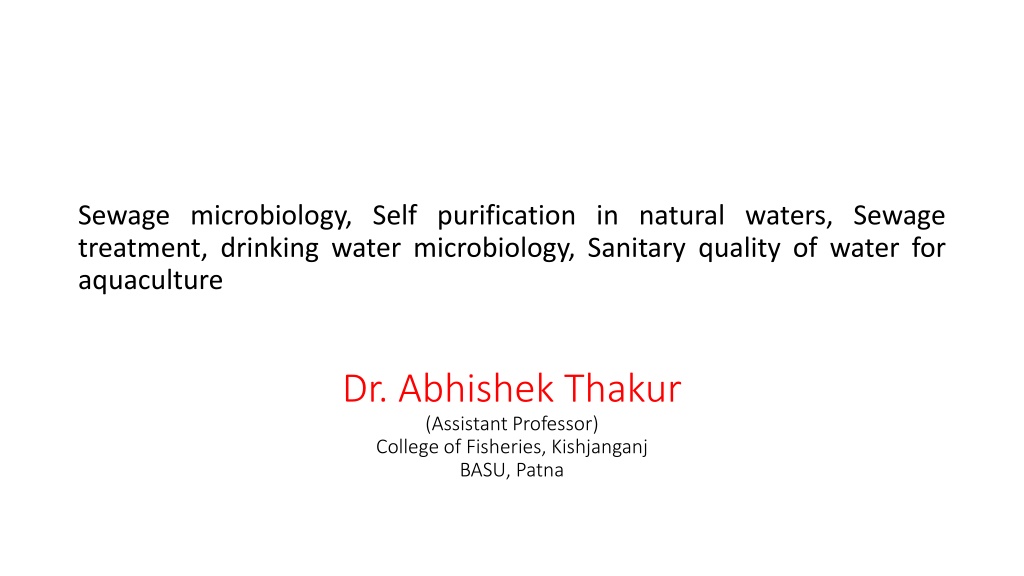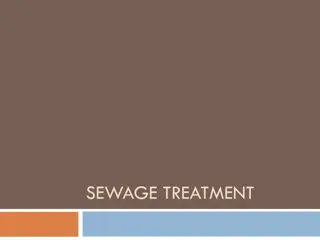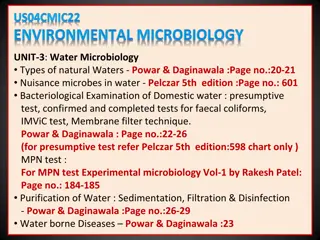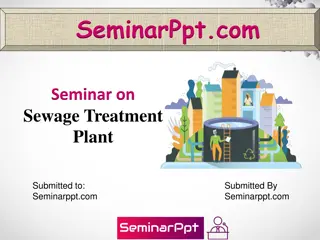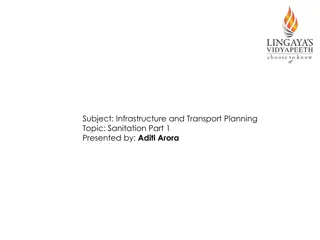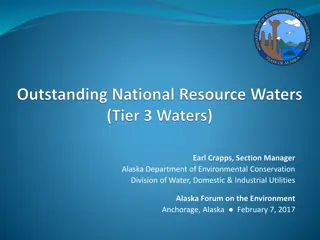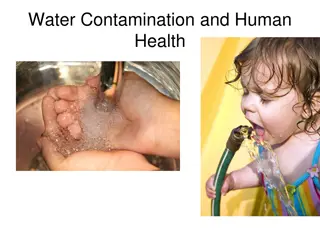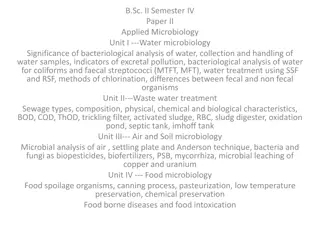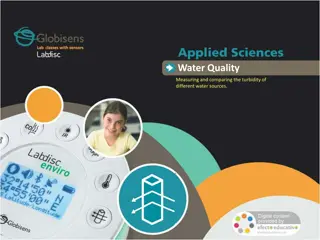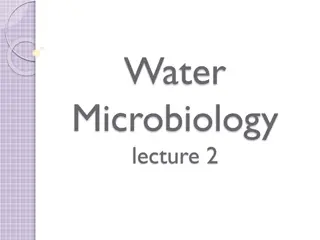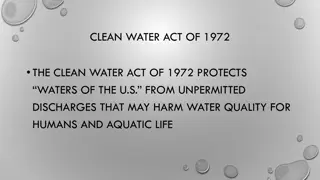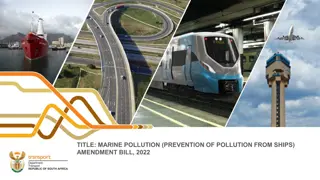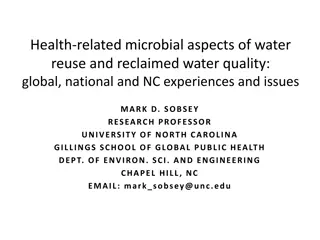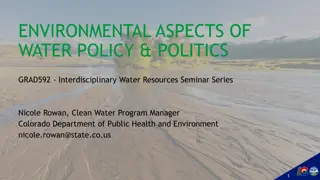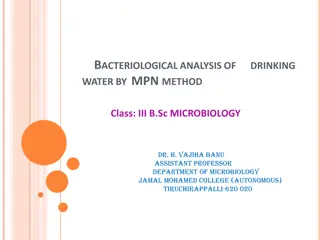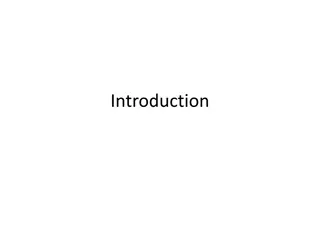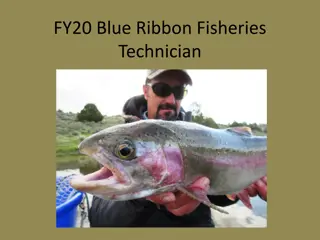Understanding Sewage Microbiology, Water Treatment, and Quality Control in Natural Waters
Dr. Abhishek Thakur, an Assistant Professor specializing in sewage microbiology, self-purification in natural waters, sewage treatment, drinking water microbiology, and sanitary water quality for aquaculture, explains the processes involved in water treatment, sewage and wastewater treatment, primary and secondary treatments, and the importance of maintaining clean water sources for various uses such as aquaculture.
Download Presentation

Please find below an Image/Link to download the presentation.
The content on the website is provided AS IS for your information and personal use only. It may not be sold, licensed, or shared on other websites without obtaining consent from the author. Download presentation by click this link. If you encounter any issues during the download, it is possible that the publisher has removed the file from their server.
E N D
Presentation Transcript
Sewage microbiology, Self purification in natural waters, Sewage treatment, drinking water microbiology, Sanitary quality of water for aquaculture Dr. Abhishek Thakur (Assistant Professor) College of Fisheries, Kishjanganj BASU, Patna
Water Treatment Water Treatment Drinking water is initially held in a holding tank / reservoir for settling the suspended matter. Then, the colloidal materials such as clay are removed from water by using flocculant chemicals such as aluminium potassium sulphate (Alum). After flocculation treatment, water is treated by filtration that is passing it through beds of sand or diatomaceous earth. Some microorganisms including protozoan cysts are removed during this process. Finally, water is disinfected with chlorine to kill remaining pathogenic bacteria.
Sewage / waste water Treatment Sewage / waste water Treatment Waste water that is water after being used is called sewage. Sewage includes household water, toilet wastes, industrial wastes and rain water. Sewage has to be treated before it is discharged into rivers and sea. Sewage treatment is done in three steps: Primary Treatment, Secondary Treatment and Tertiary Treatment.
Primary Treatment Primary Treatment It is the process of removal of solid matter called sludge from sewage. About 40 ~ 60% of suspended solids are removed by passing the sewage through sedimentation tanks. Sometimes flocculating chemicals are added to remove more solids. Primary treatment removes approximately 25% to 35% of the BOD of the sewage. BOD is a measure of the biologically degradable organic matter in water. BOD is determined by the amount of oxygen required by bacteria to metabolize the organic matter.
Secondary Treatment Secondary Treatment Secondary treatment is the biological degradation or organic matter in sewage after primary treatment. In this process, the sewage is aerated vigorously to encourage growth of aerobic bacteria and other microorganisms that oxidize the dissolved organic matter to CO2and water. Two commonly used methods of secondary treatment are Activated sludge systems and Trickling filters.
Secondary Treatment Secondary Treatment Activated sludge system consists of aeration tank where air or pure oxygen is mixed with the effluent from primary treatment and some of the sludge from a previous batch is added to the incoming water. Sludge inoculum contains large number of metabolizing bacteria, together with yeasts, molds and protozoa. Species of Zoogloea bacteria are important as they form flocculant masses in the tank and oxidizes the organic matter. Most of the settled sludge is removed for treatment in an anaerobic sludge digester. Then the effluent is sent on for final treatment. Activated sludge systems remove 75% to 95% of the BOD from sewage.
Trickling filters Trickling filters In this method sewage is sprayed over a bed of rocks or molded plastic. The rocks provide enough surface area for microbial activity and the space between rocks are large enough to provide air to the bottom. A slimy gelatinous film of aerobic microorganisms grow on rock surface and metabolize the organic matter in water when it passes along into CO2and water. Trickling filters remove 80 to 85% of BOD.
Trickling filter Trickling filter
Final Treatment Final Treatment Usually the effluent from secondary treatment is disinfected and discharged on to land or into water. Then, it is subjected to tertiary treatment. Tertiary treatment uses physical filtration and chemical precipitation to remove all the BOD, nitrogen and phosphorus from water. Tertiary treatment provides drinkable water, where as secondary treatment provides water for irrigation.
Final Treatment Final Treatment The sludge is further digested in an anaerobic sludge digester. Bacteria degrade organic matter and produce methane and CO2. In the first stage of anaerobic sludge digestion, there is production of CO2 and fermentation. In the next stage organic acids are metabolized to form hydrogen and CO2and some organic acids like acetic acid. In the third stage there are converted into methane by methane producing bacteria. organic acids by anaerobic
